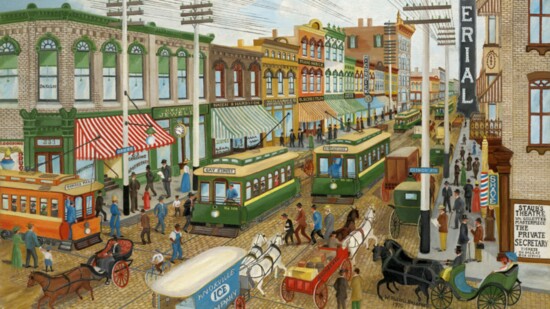During the second half of the 20th century, one of Knoxville’s best-loved painters was William Russell Briscoe (1899-1979), an artist who captured the spirit of ages past through his vivid depictions of the city’s historical events, lively street scenes, and old buildings.
Raised in the Fort Sanders neighborhood near the university, Briscoe enjoyed an idyllic childhood in a prosperous family. During World War I, he joined the Marines and was stationed in Washington, D.C. It was there that he met Deas Adams, whom he married in 1923.
Briscoe developed a long career as an insurance executive, but around 1930 he began to make his own hand-made displays for the Fidelity-Bankers Trust Company featuring a miniature railroad depot, complete with train cars and passengers. Initially, these creations were made under the name of Briscoe Manufacturing Company. But Deas recognized the potential for making and selling to the public rather than essentially just hobby pieces. With Deas’s encouragement, the couple began making wooden toys together fashioned out of California white pine. A Knoxville Journal article in December 1933 described their output:
“Deas and Russell Briscoe have a workshop in their home where they make wooden toys that would cause any child’s heart to palpitate. Long trains, wagons pulled by teams of horses, boats that really float, circus wagons with full menageries, and other things to amuse…”
Sold locally in shops under the copyright name of “Bristoy,” the Briscoes’ creations were also sold in stores in Philadelphia, Baltimore and New York.
For several decades, Russell Briscoe worked for J.E. Lutz Insurance Company on Gay Street, which was based in the Burwell Building on Gay Street (a popular vantage point for Briscoe as several of his paintings depict scenes at the busy intersection of Gay and Clinch) eventually rising to executive vice president in the firm. Over his long business career, he also served as a board member for several business enterprises relating to his love of trains, notably Southern Railway’s Cincinnati, New Orleans & Texas Pacific division, and locally with the Knoxville Utilities Board of Commissioners.
But it wasn’t until 1957 when he reached the age of 58 that Briscoe began to paint. A surprise gift of oil paints and brushes from his wife inspired him to begin painting detailed scenes of Knoxville’s past, some based on his own memories. His earliest paintings featured scenes of Knoxville’s early railroad days, “The Hill” at the University of Tennessee, and the Battle of Fort Sanders during the Civil War. The latter two themes may have been partly inspired by the neighborhood that he grew up in and later made a home there.
Retiring from his day job in 1971, Briscoe found himself in increasing demand by community organizations to give history talks, which he illustrated with his own historically based paintings. The only exhibition of his work held during his lifetime occurred in 1972 at the University of Tennessee’s Frank H. McClung Museum. Professor C. Kermit “Buck” Ewing, who began UT’s visual arts program in 1948, described Briscoe's untrained style as "American primitive", and "his fresh color, natural sense of design and thoroughness result in a personal expression of high artistic merit."
In 1976, Briscoe also turned to writing, contributing a short chapter on “Commerce and Industry” for Heart of the Valley: A History of Knoxville, Tennessee, published by the East Tennessee Historical Society.
Briscoe died three years later, just shy of his 80th birthday. He is buried in Old Gray Cemetery, but his artistic legacy lives on.
After his death, exhibitions of Briscoe’s artwork were staged at the Dulin Gallery on Kingston Pike and later at the Knoxville Museum of Art. A major retrospective exhibition was staged by the East Tennessee Historical Society in 2009. At the time, Steve Cotham, manager of the Calvin M. McClung Historical Collection described the artist’s work:
“Briscoe’s paintings capture the spirit of times long past. They are visual history that spans 189 years of life in Knoxville and East Tennessee. The collected works depict landmarks and events, both public and private, from Smoky Mountains to Gay Street, from battlegrounds to churchyards, from trolleys to trains. Minute details, meticulously drawn, show a draftsman’s hand. Painstaking brushstrokes, applied in vivid colors, reveal a heart deeply connected to home and heritage. His work is respected among artists for its skillful execution, and among scholars for its historical accuracy.”
Today, you can enjoy a display of 25 Briscoe oil paintings at the East Tennessee History Center, on the third floor within the McClung Historical Collection.
ABOUT KHP
The nonprofit Knoxville History Project tells the city’s stories, focusing on those that have not been previously told and those that connect the city to the world. Donations to support the work of the Knoxville History Project, an educational nonprofit, are always welcome and appreciated. Learn more at KnoxvilleHistoryProject.org
Images courtesy of East Tennessee Historical Society, Knoxville TN, and Mike O’Neill
Two of Briscoe’s paintings are featured in KHP’s Downtown Art Wraps program. The Staub Opera House art wrap is located where it once stood on Gay Street at Cumberland. The East Tennessee Female Institute art wrap stands near where that building once stood, overlooking the Tennessee River from 1827 until about 1890, at Henley Street and Cumberland.
